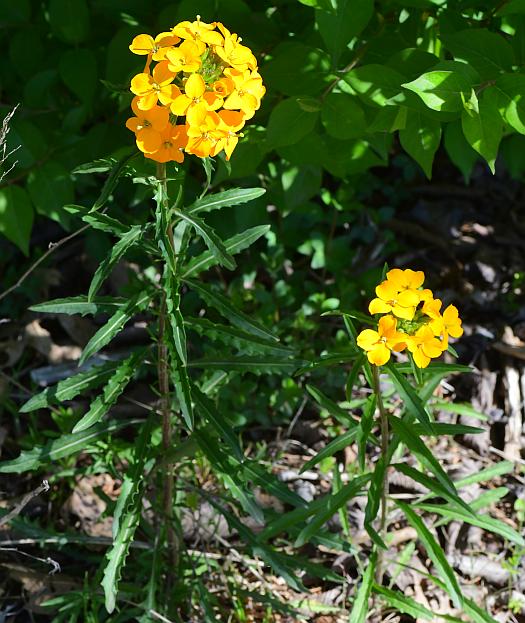Erysimum capitatum (Douglas ex Hook.) Greene
Western Wallflower

Native
CC = 8
CW = 5
MOC = 15
© SRTurner
Erysimum capitatum (Douglas ex Hook.) GreeneWestern Wallflower | |
 |
Native CC = 8 CW = 5 MOC = 15 |
© SRTurner |
|
Family - Brassicaceae Habit - Biennial or perennial forb, from a taproot. Stems - Erect, to 90 cm, 1 or few per plant, usually unbranched below the inflorescence, pubescent with appressed, mostly 2-branched hairs.
Leaves - Alternate, short-petiolate at the base, sessile above, 2-12 cm long, narrowly elliptic to linear-lanceolate, the margins entire or shallowly and broadly toothed, pubescent with appressed 2-and 3-branched hairs.
Inflorescence - Terminal raceme. Pedicels to 5 mm long in flower, slightly longer in fruit, ascending, with pubescence as the stem.
Flowers - Sepals 4, erect, 7-15 mm long, light green, often slightly keeled. Petals 4, 15-30 mm long, clawed, distinct, the claw yellow, to 1 cm long, the limb orange, sub-orbicular, to 9 mm long, glabrous. Stamens 6, erect. Filaments greenish-white, glabrous, compressed, 1 cm long. Anthers greenish, 2 mm long. Ovary densely appressed pubescent (the hairs forked and arranged vertically), 1 cm long. Styles 0.5-5.0 mm long. Stigma capitate.
Fruits - Siliques, erect or ascending, beaked, 3-9 cm long, usually somewhat 4-angled in cross-section, pubescent with 2-5-branched hairs, the stalks relatively stout and about as wide as or slightly narrower than the fruits. Seeds 2.0-3.0 mm long, oblong-elliptic in outline, somewhat flattened, sometimes with a narrow wing at the tip. Flowering - April - July. Habitat - Limestone bluffs, glades, rocky open ground. Origin - Native to the U.S. Lookalikes - None. Other info. - This biennial species is certainly the most showy of the family in Missouri. The large flowers which typically have a richly saturated orange color are unique among Missouri's flora. The plant can be found mainly in the north-central Ozark region and is mostly restricted to the habitats mentioned above. It is fairly uncommon in Missouri, but very common in western states. The plant grows well from seed and makes a fine garden subject. It is sometimes cultivated, and specimens collected along roadside embankments may represent escapes. Photographs taken off Hwy 29, Guilford County, NC., 4-23-03 (DETenaglia); also at West Tyson County Park, St. Louis County, MO, 5-3-2015; and near Cedar Hill, Jefferson County, MO, 4-15-2021 (SRTurner). |